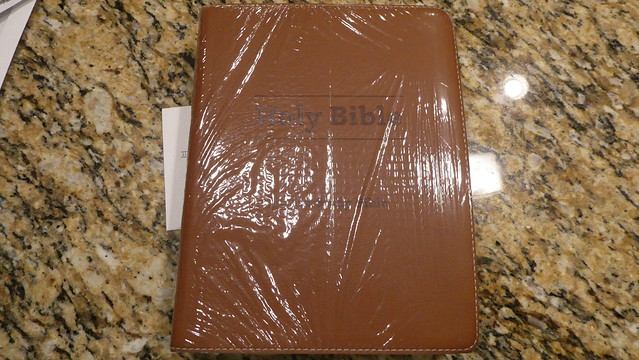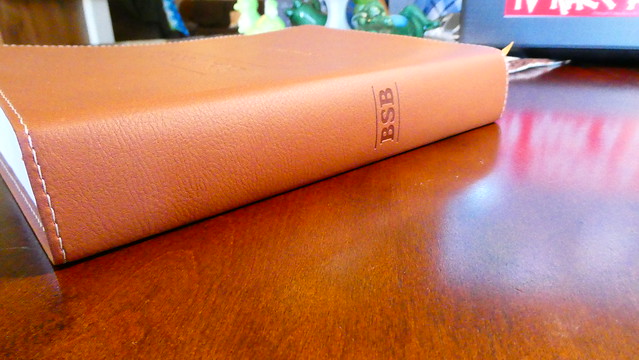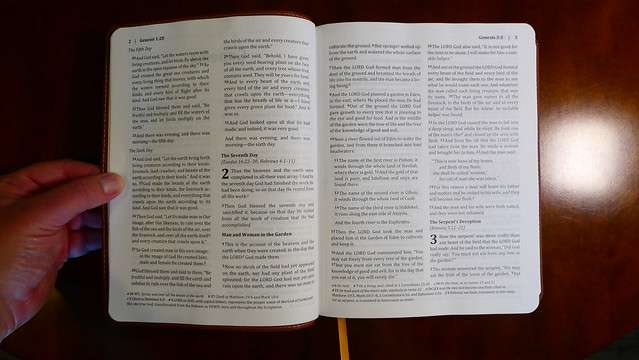I was unaware of this translation being available in a printed physical edition until I saw one on social media. One of my online friends had recently been touting it as possibly being, “The one.” He has been looking for an accurate translation that reads well. Many of us are longtime fans of Lockman’s 1995 New American Standard Bible. (N.A.S.B.) It has been a reliable formal equivalent translation since its release. We haven’t been looking for a new translation, but some were not satisfied so the 2020 NASB became a reality.
The 2020 NASB has been well received by many, but others like me, were not happy with many of the translation choices made in this most recent work. Some of us have been looking for a replacement that reads, “better.” This subjective preference is responsible for the majority of NASB readers opting to adopt the 2020 NASB.
Others like myself are waiting for something with a stricter translation philosophy. Enter the Legacy Standard Bible (L.S.B.) Master’s Seminary has been working on tightening up the translation work of the 1995 NASB. They have released a New Testament with Psalms and Proverbs. The entire Bible will be released later this year, God permitting. I’m still in this camp. (For the time being.)
My friend and his like-minded counterparts insist on an accurate translation, that handles the Hebrew and Greek gendered words properly without the addition of modern sociopolitical ideologies being utilized in the interpretive process. Along with these core principles they also want a translation that is more accessible than the 1995 NASB was in their opinion. This is where the BSB comes in.
I really didn’t want to like the BSB, and was looking at sections of scripture, and their translation choices very critically. I wanted to find a reason to not like it. I attribute this bias to the fact that a bunch of the people I know on social media were fawning over it ad nauseam. It was like being forced to watch your friend and his new girlfriend baby talk each other. So, being the reasonable adult that I am, I requested a Bible for review. I hadn’t really considered my bias against the BSB until I began using it for my daily reading. I am usually critical of, “new” translations. Especially given the horrible track record of some new translations. I proceeded to use the BSB the way I normally do when I get a new Bible for review. I try to live with it for a while and use it side by side with my 1995 NASB, and some language tools on my computer. (I like Olive Tree’s Bible Study program. I’ve invested a good amount of cash on these tools, but not as much as my Logos friends.) When I read a section that seems different to me, I compare it the NASB, then I look up the Greek in Novum Testamentum Graece (NA28) in the Bible Study app.
I need to state a disclaimer here. I am not a Koine Greek expert. I have had more Koine Greek than some Preachers, but not as much as I would need to be a translator. With that out of the way, keep in mind that all translation involves interpretation. You can have a valid translation of a section of scripture that is quite different than another person’s. This is why you need to have an education in the original languages instead of simply using concordances, and computer programs. It is like having a semester of philosophy and presuming you can fix all the worlds problems. Without the education, you aren’t aware of the period in history, the idioms, ways in which a specific word was primarily used, other extrabiblical contemporary texts to cross reference usage, regional differences, translation conventions, some textual criticism, and so on.
Since God is the author, and we want to understand what He intended to communicate, we need to seek to interpret what we are translating in such a way that His intended ideas are communicated. Just because a translation is linguistically valid does not necessarily make it a good or bad translation.
I started coming around after the first week of using the BSB. I don’t think it will be, “the one” for me, but it is one that I will use. I am still waiting for the LSB. I’d be very very interested in the Berean Literal Bible. I asked about it in one of my e-mail correspondences with John at Bereanstudybible;
Q: “Are there plans to make a physical edition of the BLB?”
A: “We are hoping to offer the full draft OT and NT of the BLB online around the end of the year or early in 2022. Following that time there will be a period for additional translation input, public comment, and consistency checking. For the full BSB this period was about 2 years before finalizing and beginning the printing process, so a comparable time period is expected before a BLB printing.”
I am excited for this translation. After using the BSB, it seems to me to be more formal than the first era NIV’s, which utilized a dynamic translation philosophy, and less formal than the ESV. I’d add it seems more formal than the CSB in my opinion. I do like the translation, in as much as I’ve been exposed to it. I can tentatively recommend the BSB as a translation.
Beyond the translation we have to talk about the actual physical Bible itself. It was shipped in a card-paper envelope with minimal protection. Inside it was in plastic. I hoped it wasn’t damaged. When I opened it up, it was apparent that the text block was exceptionally manufactured. I was impressed at how flexible it was, as well as the paper’s thickness. My first impression was that the spine was smyth sewn. I thought to myself, “Surely it isn’t sewn since it only costs around forty bucks?” I made sure to ask about it.
Q: “What process was employed to manufacture the spine?”
A: “The Printer was Sheridan in Grand Rapids MI and the Case Binding for the Softcover was done at Bintech in Nashville, TN. The Bibles are Smyth Sewn Flex bound (Caseside).”
As many of you know by now, there has been further verification of this by the re-binders who have since posted pictures of the spine to social media. The paper is 45 g.s.m. which is 30.5# with 88% opacity. The inside liner that connected the text block to the cover was a nice change. It was flexible, tough, and didn’t wrinkle as bad as traditional materials.
The cover material is called, “Alpha Aston” manufactured by Ecologicalfibers Inc. The cover material is already starting to show damage from use. I would not trust this cover material to last a long time. Synthetics can be cost effective, but they are rarely as durable as a good quality leather.
This Bible was printed by Sheridan in Grand Rapids Michigan U.S.A. I am happy about that. I really don’t like it when slave labor is used to print a Bible.
The print is a double column, paragraph format, black text edition, in 10 point font. It is clearly printed for the most part with only a few noticed smears of the text. There are some translation notes at the foot of the page.
Here are some more questions and answers from my correspondence with them;
Are you structured as a ministry, not for profit, non-profit, or something else?
Bible Hub is privately owned. I would say it is structured as a ministry (but supported by advertising so does not take donations.) The translation work was commissioned using ad revenue from the Bible Hub site.
How important is it to the translators to directly translate, when possible, gendered nouns, and pronouns, and allow the reader, with the surrounding scriptural contexts, to come to the correct conclusions?
The translators seek to be true to the original Scripture text regarding gender. Pronoun clarification was permitted where helpful to the reader. Clarifications, parsing, and variants are indicated in the word by word translation tables which are freely available at: https://berean.bible/downloads.htm
Are there plans to make a physical edition of the BLB?
We are hoping to offer the full draft OT and NT of the BLB online around the end of the year or early in 2022. Following that time there will be a period for additional translation input, public comment, and consistency checking. For the full BSB this period was about 2 years before finalizing and beginning the printing process, so a comparable time period is expected before a BLB printing.
Q: “Are there any plans to produce different text blocks? i.e. single column, verse format, personal size, thinline, so on and so forth?”
A: “Depending on sales, a personal size is most likely next. The other options are also strong considerations for the future, but not likely in the very near future.”
Q: “What has your experience been working with an American printer for this edition?”
A: “We have worked with Sheridan (formerly Dickinson) in Grand Rapids for both the NT and full printing and are very happy with their work. Since we are printing in smaller volumes in this early stage, printing in the US is a cost effective solution. Since we are located in the US we prefer to work locally as long as it is reasonably cost effective.”
Overall, I found the translation to be sound. The Bible size was just right allowing for a very comfortable and legible font size. The binding was my favorite feature. The flexible text block should also prove to be durable. The only negative I really have is about the flexible synthetic soft cover. I don’t think it will last long. The text block really deserves a better cover option. I think many people agree as I have seen numerous rebinds on social media. I am looking forward to their future work. Make sure to check out the rest of the photographs on my Flickr page, and watch the youtube video.
















Bob, I a looking for a premium goatskin KjV bible with 12 point font. I must be the very best quality. edges stitched and glued, 3 ribbons, referances, full or generous yapp. prefer double column. Something like an Allan bible quality. Can you help me? Thanks, Timothy at timberlys55@hotmail.com Please reply
LikeLike
R. L. Allan, Church Bible Publishers, Local Church Bible Publishers, Cambridge, honestly R. L. Allan is your best bet for all the features you would like.
LikeLike
Mr. Bob,
Just got my new BSB today and really enjoyed to format of the Bible, and the white space on the Page.
I was comparing it to the brief list of missing verses.
It seem to follow the same list of the missing verses in the NIV.
https://en.wikipedia.org/wiki/List_of_New_Testament_verses_not_included_in_modern_English_translations
Why do they feel compelled to take away these verses?
They are in the KJV, not an issue for over 500 years and all of a sudden everyone seems to think now
that they can change the Bible anyway they want.
Or am just picking at straws?
Are these verses just not important?
Who says the earliest manuscripts are the most accurate?
If that is the case, then why have Revelation, being the last book written?
It was in the earliest manuscripts.
One minster said that good version is the one they gravitate toward reading.
It becomes their favorite.
Just hope the Legacy bible is left alone and has all the verse.
I was hoping the BSB was going to be the Bible for me.
Good size text.
Cover is nice.
White paper.
Pages with plenty of white space and the verses are not squeezed together which is a major problem today.
I think I am going to stay with my NASB 1995 at least until the Legacy bible comes out.
LikeLike
There is nothing wrong with the older text collections. There is no reason to believe that the KJV had it right. They had less information to inform their decisions at that time during the translation process. Cross referencing older collections of texts from different regions often demonstrates that these allegedly missing verses aren’t missing verses at all, but rather redundant and erroneously placed verses in the KJV. If anything, the KJV is more erroneous that the later versions that were more careful in the comparisons of text collections. I do like that the ’95 NASB denotes these passages by bracketing them. I would also like to see the LSB do something similar, but it wouldn’t bother a bit if they didn’t. It isn’t a matter of if all of the earlier texts were, “most accurate.” It is a matter of cross referencing all available collections of texts, in various languages, and seeing what is the most consistent flow of text through history, and regions. Then with that greater amount of evidence, we can compile and translate. I hope that helps. You asked, “Why do they feel compelled to take away these verses?” I don’t know anything about the feelings of any of the translation teams, on any of the latter translations that occurred after the KJV. I don’t know their thoughts either. That is an impossible question for me to answer. You also asked, “Or am just picking at straws?” I think you meant, “picking at nits/nitpicking.” “Grasping at straws” is an entirely different idiom. I don’t think it is a wasted effort to try to make sense of how a translation of the Bible comes together. However, there are so many misleading arguments, and bad actors out there that the average Christian is hard pressed to make a good decision about these translations. Textual criticism is an endeavor that most people are ill equipped to set out on. If you truly want to study the history of the Bible, and textual criticism, I’d encourage you to enroll at Master’s Seminary, or Westminster West. James White has written on several topics including the KJV translation. I’d encourage you to read some of his work if you don’t want to attend seminary, and I don’t blame you for that lol. It is quite the undertaking. The case for the revelation of Jesus to John being part of the canon is not a difficult one to make. That would be a very poor argument for not using other translations besides the KJV. There are, in fact, several decent translations out there. I happen to value the ones that leave more interpretation up to me, and remain more literally translated. I don’t want the translations to do interpretation to make the translation easier on me, but that means I have to learn more Greek and Hebrew, as well as English. If a person doesn’t want to do that, or isn’t able, I recommend these translations to them. I’m looking forward to the literal translation from Biblehub, the folks who brought us the BSB. I’m switching to the LSB as soon as it comes out. I will switch all of my tools over to it. I still recommend the ESV, ’95 NASB, NKJV, and 1599 Geneva before I recommend the KJV, but I do recommend it. It is a valuable historic translation. The Geneva translation is the one the Puritan pilgrims brought to America with them.
LikeLike
Great post.
I have read through the whole BSB and all I can say is what an excellent translation, I found nothing wrong with its translation decisions. The Berean Study Bible sounds like the NKJV (words like “unto, behold, brothers”, etc.) but reads at times like the NIV. The BSB is better, in my personal opinion than the NIV, ESV, NKJV, because It’s more conservative than the NIV and more readable than the ESV, and NKJV. My personal best Bible translations that are readable and faithful to the Hebrew and Greek would be as follows the BSB, HCSB, NIV (for readability), and the NASB 2020,
LikeLike
I’ve been reading the Legacy Standard Bible since it was published, and truly appreciate their translation philosophy. If I were to pick a dynamic equivalent, it would be the BSB. The LSB has my vote for formal equivalent translations.
LikeLiked by 1 person
I might in the future get one. Right now, all of my highlights are in the HCSB (2009 Ed). I’m going through it again. I love that translation.
LikeLike